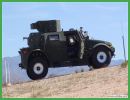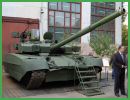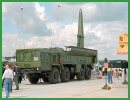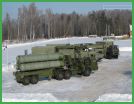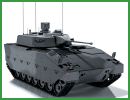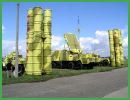| |
| |
Russia
 Back
Menu
Back
Menu
New combat
uniform for the russian army troops for 2013.
All
soldiers of the Russian Army will adopt a new uniform
before 2013, announced this 30 July 2010 to the journalists
the vice-minister of Defense, the general Dmitri Boulgakov.
“From the autumn 2010, all the sergeants and the
troops making their military service under contract
or called will carry a new uniform. In this way, from
here the autumn 2012, all the categories of soldiers
will change uniform. We plan to complete the passage
to the new uniform before 2013”, specified the
general. According to the ministry for Defense, 150.000
Russian officers already obtained new a summer uniform.
“This year, 100% of soldiers making their service
in the areas with hot climate will be equipped in a
new uniform designed for these areas”, concluded
the general.
30 July 2010 |
|
|
|
| |
United
States (BAE Systems)  Back
Menu
Back
Menu
BAE Systems-Northrop
Grumman add members to ground combat vehicle team.
BAE
Systems and Northrop Grumman today announced additional
members to their GCV team in their bid for the U.S.
Army's Ground Combat Vehicle (GCV) competition. "We
have built a team that has extensive experience and
innovation in the development and production of combat
systems and subsystems," said Mark Signorelli,
vice president and general manager of Ground Combat
Vehicles at BAE Systems. "With this team we bring
more to our customer by providing a vehicle that will
meet the Army's requirements for a highly survivable
platform that can adapt to a constantly evolving and
changing operational environment; from humanitarian
relief to a full scale battlefield." Each teammate
will bring a different capability to GCV that will help
to strengthen the BAE Systems-Northrop Grumman team
offering. As the prime contractor, BAE Systems will
provide the overall program management and systems integration
for GCV and will also be responsible for providing the
vehicle design, structure, logistical support as well
as the readiness and sustainment of the platform. Northrop
Grumman will serve as the C4ISR (command, control, communications,
computers, intelligence, surveillance and reconnaissance)
lead. QinetiQ North America will provide the electric
drive propulsion system or E-X-Drive™ for Ground
Combat Vehicles. The E-X-Drive is the key component
of the hybrid electric drive system, which minimizes
electrical demand, saves on vehicle fuel costs, improves
reliability, provides higher dash speed and acceleration
and increased on-board and off-board power. Saft will
provide the energy storage system for the GCV. The BAE
Systems-Northrop Grumman GCV offering will be the first
combat vehicle designed from the ground-up to operate
in an IED-threat environment. The team's offering will
provide survivability, mobility and versatility that
will address the operational requirements of the customer.
The GCV mine survivability will exceed that of a Mine
Resistant Ambush Protected vehicle, while the enhanced
mobility capabilities will allow the GCV to operate
in urban and cross country environments. The team's
vehicle will also have an integrated electronic network
capability and embedded intelligence, surveillance and
reconnaissance assets to connect the warfighters. The
open architecture electronics will also be adaptable
to future network upgrades as new technologies mature.
The modular armor system will allow the unit commander
to rapidly apply or remove kits in the field to adjust
to the tactical situation. BAE Systems is the top producer
of combat vehicles in the world and provides nearly
80 percent of the vehicles in the Heavy Brigade Combat
Team (HBCT). The GCV program is a development effort
headed by the U.S. Army to develop the first combat
vehicle designed from the ground up to operate in an
IED-threat environment.
27 July 2010 |
|
|
|
| |
United
States (General Dynamics)  Back
Menu
Back
Menu
General Tactical
Vehicles (GTV) team of General Dynamics Land Systems and AM General
today delivered two Right-Hand Operation (RHO) Joint Light Tactical
Vehicles (JLTVs).
The
General Tactical Vehicles (GTV) team of General Dynamics
Land Systems and AM General today delivered two Right-Hand
Operation (RHO) Joint Light Tactical Vehicles (JLTVs),
one companion trailer and supporting equipment on schedule
to the U.S. government for Technology Development (TD)
phase testing in support of the U.S. and Australia’s
Land Force Capability Modernization Project Arrangement
(PA). The PA enables tactical vehicle interoperability
and integration between the two countries. Delivery
of the RHO JLTVs follows GTV’s previous ahead-of-schedule
deliveries of armor samples, ballistic hulls, seven
vehicles and four trailers and spare parts for the TD
phase. Test and evaluation of the RHO JLTVs includes
a five-month reliability and durability test and evaluation
process at the Monegeetta Proving Ground in Monegeetta,
Victoria, Australia. Test site management for GTV will
be performed by General Dynamics Land Systems-Australia
and supported by Australian in-country suppliers. The
JLTV TD phase is intended to validate the integration
of mature technologies as a complete vehicle system,
rebalancing payload, protection and performance while
maintaining transportability and expeditionary capabilities;
give the Army, Marine Corps and the Australian Defence
Force an accurate assessment of the technical and performance
capabilities and risks associated with entering the
Engineering and Manufacturing Development (EMD) Phase;
and establish a realistic set of requirements for the
JLTV program.
21 July 2010 |
|
|
|
| |
Ukraine
 Back
Menu
Back
Menu
The Ukrainian
army could decrease its manpower by 20% per 2015.
Ukraine
is to downsize its Armed Forces by some 20% to 150,000-160,000
personnel in five years, the government press service
said on Thursday. The cuts are envisioned under a draft
concept for the organizational development of the national
Armed Forces. The country presently has about 200,000
servicemen. Alongside the cuts in personnel, the draft
concept states that military spending should grow at
a rate of 15-20% a year through 2015. The Armed Forces
are also to sell off surplus military property, which
should yield $188 million to $250 million. The concept
also directs the Defense Ministry to make a more effective
use of its internal resources, saving an additional
$2.4 billion.
20 July 2010 |
|
|
|
| |
Israel
 Back
Menu
Back
Menu
Israeli
Iron Dome air defense ready to be deployed.
The
Israeli Defense Ministry has reported that tests of
the Iron Dome air defense system have been completed
and that interceptor missiles will soon be deployed.
The final tests of the Israeli air defense system designed
to intercept short-range rockets and artillery shells
were successfully carried out on Monday, the ministry
said in a statement. First Iron Dome interceptor missiles
are expected to be deployed by November. Israel moved
to develop the Iron Dome air defense system following
years of fighting against Palestinian militants in the
Gaza Strip. The militants had fired thousands of short-range
rockets at Israel until Operation Cast Lead in December
2008-January 2009 put an end to massive Palestinian
attacks. The war claimed the lives of some 1,500 Palestinians.
During a month-long war with Lebanon in the summer of
2006, militants of the Shiite armed group Hezbollah
have fired some 4,000 short-range rockets at northern
Israel. The cost of a single Iron Dome missile launch
is estimated at tens of thousands of dollars, while
a single launch of a Qassam rocket is ten times cheaper.
20 July 2010 |
|
|
|
| |
Russia
 Back
Menu
Back
Menu
Iskander
SS-26 missiles had entered service with the Armed Forces in the Leningrad
Military District.
The
deployment of Iskander missiles in Russia's northwestern
military district is incomprehensible in view of Russia's
current relations with NATO, Estonian Defense Minister
Jaak Aaviksoo has said. On Saturday, the chief of Russia's
Ground Forces, Col. Gen. Alexander Postnikov, said the
Iskander missiles had entered service with the Armed
Forces in the Leningrad Military District. "During
the past two decades, NATO has been seeking benevolent
mutual understanding in relations with Russia. But benevolence
does not mean naivety, that is why Moscow's decision
to deploy Iskander missiles in the Kaliningrad region
did not surprise us," Aaviksoo said. "We do
not comprehend such a step considering both modern security
threats and current relations between Russia and NATO,"
he said. The United States scrapped earlier plans last
September for an antimissile defense system in the Czech
Republic and Poland. Moscow welcomed the move, and President
Dmitry Medvedev said later that Russia would drop plans
to deploy Iskander-M missiles in its Kaliningrad Region,
which borders NATO members Poland and Lithuania. However,
Washington has not given up on its European missile
shield initiative. In May, the United States opened
a temporary military base in northern Poland, just 80
km (50 miles) from the border of Russia's Baltic exclave
of Kaliningrad, in accordance with an agreement negotiated
under former President George Bush in 2008 – a
move which drew much criticism from Russia.
20 July 2010 |
|
|
|
| |
Armenia
 Back
Menu
Back
Menu
Armenian
defense minister heads to Iran.
Armenian
Defense Minister Seiran Oganyan will visit Iran on July
17-18 on an invitation from his counterpart Ahmad Vahidi,
the Armenian Defense Ministry reported. "During
the visit, the minister will hold talks with his Iranian
counterpart," the ministry said. "Meetings
with Iran's military and political leaders are also
planned," it said. The sides will discuss regional
and international issues, as well as topics of bilateral
interest. Iran and Armenia are neighbors. They have
had long-lasting relations of a strategic partnership.
Bilateral ties in particular develop in energy, trade,
sports, tourism and transportation. On June 9, the UN
Security Council passed a resolution imposing a fourth
set of sanctions on Iran over its nuclear program, including
tougher financial controls and an expanded arms embargo.
The West suspects Iran of pursuing a secret nuclear
weapons program, but the Islamic Republic says it needs
nuclear power solely for civilian purposes.
17 July 2010 |
|
 |
Armenian
Defense Minister Seiran Oganyan picture |
|
|
| |
Iran
 Back
Menu
Back
Menu
Russia Still
Bound to S-300 Missile Contract with Iran.
A
top Russian military official said the S-300 defense
system deal with Iran is pending the decision of President
Dmitry Medvedev and has not been cancelled yet. "The
contract on supplying S-300 air defense systems to Iran
has not yet been cancelled," RIA Novosti quoted
Sergei Chemezov, the chief of Russia's military conglomerate
Rostekhnologii as saying. "The final decision on
signing or dropping the contract must be made by the
President." Moscow signed a contract with Tehran
in 2007 to supply the powerful S-300 missiles to Iran
but it has refrained from delivering the system to the
county due to the US and Israeli pressures. The S-300
surface-to-air system, known as the SA-20 in the West,
can track targets and fire at aircraft 120 kilometers
(75 miles) away. It also features high jamming immunity
and is capable of simultaneously engaging up to 100
targets. Meantime, an Iranian top military commander
had announced several months ago that Tehran is able
to replace the Russian-made anti-aircraft S-300 missiles
with other air defense systems. "If they do not
deliver S-300 defensive system to us, we have replacements
and we can supply our operational requirements through
innovative techniques and different designs," Deputy
Commander of Khatam ol-Anbia Air Defense Base for Coordination
General Hassan Mansourian said in November.
16 July 2010 |
|
|
|
| |
Russia
 Back
Menu
Back
Menu
Russia's
new generation S-500 air defense system will resolve the country's missile
defense problems
Russia's
new generation S-500 air defense system will resolve
the country's missile defense problems when it enters
service, Air Force Commander Colonel General Alexander
Zelin said on Tuesday. "The S-500 air defense system
is a system that will solve Russia's missile defense
problems," Zelin said. Answering a question about
the S-500's technical specifications, Zelin said: "I
would not compare the S-500 with the U.S. missile defense
since they have different technical characteristics".
The S-500 is expected to have an extended range of up
to 600 km (over 370 miles) and simultaneously engage
up to 10 targets. The system will be capable of destroying
hypersonic and ballistic targets. He also added that
two S-400 long-range missile defense systems would be
delivered to the Far East by the end of 2010. "We
are planning to put two S-400s on combat duty at the
Vostok strategic command," Zelin said.
13 July 2010 |
|
|
|
| |
Sweden
(Saab)  Back
Menu
Back
Menu
Saab Receives
New Order on Advanced Camouflage Solutions.
Defence
and security company Saab has been awarded a new large
contract for multispectral camouflage products and services.
The order has a total value of approximately MSEK 670.
Deliveries will start during 2010 and continue for four
years. At the customer's request and due to the nature
of the order, no details about the contract or the customer
will be made public. “We are proud to be selected
and it further proves Saab’s unrivalled position
as the world-leader within signature management technology.
We continue to attract new and existing customers around
the globe,” says Tomas Samuelsson, head for Saab’s
business area Dynamics. Saab Barracuda’s advanced
camouflage technology products have until now been exported
to more than 50 countries. Saab Barracuda offers a unique
package of camouflage systems and force protection solutions
with the purpose to decrease the enemy’s ability
to detect and engage. These solutions protect camps,
vehicles and personnel against hostile sensors and enemy
target acquisition.
13 July 2010 |
|
|
|
| |
Iran
 Back
Menu
Back
Menu
Iranian
Air Force to Deploy UAVs along Borders.
The
Iranian Air Force plans to deploy reconnaissance drones
along the country's border, an Air Force commander announced
on Sunday. Speaking in an interview with FNA, Deputy
Lieutenant Commander of Army's Air Force for Operations
General Majid Pirhadi underlined that Unmanned Arial
Vehicles (UAVs) will cover all the country's border
regions in the near future. "We are seeking to
equip all the country's central (air) bases with long-range
UAVs but for now equipping bases along borders sets
a priority," Pirhadi stated. The commander highlighted
the growing applications of UAVs in Iran's armed forces,
and announced that the Air Force command headquarters
plans to form a command-and-control center for UAVs.
"Utilization of the UAVs plays a vital role in
the strengthening of the Armed Forces' offensive and
defensive capabilities. Accordingly, we seek to equip
all the country's air bases with different types of
drones," he noted. The commander added that all
border bases in western and southern Iran will be equipped
with UAVs by the end of summer (September 2010). He
mentioned that these drones are currently tasked with
intelligence and information gathering and reconnaissance
missions and that the Iranian Army plans to use different
types of drones for combat, reconnaissance, disruption
and communication missions. Earlier in June, Lieutenant
Commander of Iran's Air Force Mohsen Darrebaqi told
FNA that the Iranian Air Force plans to form a battalion
of Unmanned Aerial Vehicles (UAVs) in all its bases
across the country. Iran successfully tested a home-made
radar-evading UAV with bombing capabilities last June.
Also in 2008, the country's Defense Industries launched
production lines of two well-known home-made fighter
jets, namely Saeqeh (Thunderbolt) and Azarakhsh (Lightening).
Iran had earlier started construction of a plant in
the northern province of Mazandaran in 2008 to mass
produce UAVs for different civilian and military missions.
06 July 2010 |
|
|
|
| |
Russia
 Back
Menu
Back
Menu
Russia set
to buy Mistral with transfer of French technologies.
Russia
will buy French Mistral class helicopter carriers with
the complete set of navigational equipment and technical
documentation, but equip the ships with its own weaponry
and helicopters, a defense industry source said Monday.
Russia is negotiating the purchase of at least one French-built
Mistral class amphibious assault ship and plans to build
two or three more vessels of the same class in partnership
with the French naval shipbuilder DCNS. "I would
like to stress the point that we are buying the Mistral
with all proper navigational and technological equipment,
including the fire control systems," a source close
to the negotiations said. "We will use our own
helicopters on the Mistral, but we will have to raise
the deck for that purpose," he said. According
to other defense industry sources, the Russian Air Force
plans to buy up to 100 Ka-class helicopters, including
some 70 Ka-27Ms, to equip the Mistral ships. The Mistral
class ship is capable of transporting and deploying
16 helicopters, four landing barges, up to 70 armored
vehicles including 13 battle tanks, and 450 personnel.
"We are also planning to use this helicopter carrier
in northern latitudes, in ice floe. For that we will
need to reinforce the hull of the ship, but it will
not seriously change its structure or technical equipment,"
the source said. The Russian military has said it plans
to use Mistral ships in its Northern and Pacific fleets.
Many Russian military and industry experts have questioned
the financial and military sense of the purchase, and
some believe that Russia simply wants to gain access
to advanced naval technology that could be used in the
future in potential conflicts with NATO and its allies.
In April, the head of the Federal Service for Military
and Technical Cooperation, Mikhail Dmitriev, said the
Mistral deal would be concluded by the end of the year.
06 July 2010 |
|
|
|
| |
United
States (Force Protection)  Back
Menu
Back
Menu
Force Protection
Meets With Potential Suppliers for Australia`s $1 Bn Vehicle Contract
Force Protection has completed a series of discussions
with potential suppliers across four states as it refines
its Australian manufacturing plans for the $1 billion
protected mobility vehicle contract. The Australian
Government in May announced that Force Protection was
one of three Australian-based solutions to be given
the opportunity to win the contract to manufacture up
to 1300 next-generation protected mobility vehicles,
under the 'Land 121 Phase 4' program. Force Protection
has again met with potential suppliers as well as State
Government ministers and industry representatives in
New South Wales, Queensland, Victoria and South Australia.
Force Protection Chief Executive Officer, Michael Moody,
said discussions with suppliers last year had opened
up several manufacturing options for its Ocelot vehicle
across the four states, and it was important to further
progress these discussions now that the company had
been short-listed for the Australian Government contract.
"The reception we have received from both suppliers
and government representatives over the past couple
of weeks has been extremely positive, and confirmed
our view that we can build a world class vehicle utilising
the best of Australian military and automotive manufacturing
expertise and know-how," Mr Moody said.
05 July 2010 |
|
|
|
| |
Russia
 Back
Menu
Back
Menu
Russia to
expand world's largest training ground in Siberia.
World's
largest Telemba military training ground located in
Siberia will be expanded within the recent time so that
it to host tests of S-400 long-range missile defense
systems, Col. Sergei Kuryshkin, Telemba's chief said
on Saturday. Telemba training ground was established
in November 1960, its total area is more than 1.3 million
hectares. The range is located in Siberian Buryat Republic.
This military training ground is the largest one in
the world. Not only Russian but also Syrian, Ukrainian
and Belarusian armed forces hold drills there. "We
currently coordinate transferring of additional... parcel
of land to the tanning ground with Buryat Republic leadership,"
Kuryshkin said, adding that the length of the parcel
is 160 kilometers and its width is 70 kilometers. Kurryshkin
said the training ground would be used to for S-400
long-range missile defense systems tests as well as
for other prospective missile defense systems.
03 July 2010 |
|
|
|
| |
Russia
 Back
Menu
Back
Menu
Ground-to-air
missiles S-500 will be in advance from 15 to 20 years on knowledge of
the supposed enemy.
Developed
in Russia, the ground-to-air missiles S-500 will be
in advance from 15 to 20 years on knowledge of the supposed
enemy, declared Saturday Sergueï Popov, commander
of the aerospace brigades of the Russian Air force,
in the program “the Council of war” to the
national radio Echo of Moscow. These ground-to-air missiles
S-500 are intendece ministre ned to replace S-400 Triumph
able to organize the spread out defence of the sites
against a massive air attack. The S-500 missiles will
be able to destroy 10 targets against 6 for S-400. The
Russian defence aerospace brigades will be equipped
with it. Weapons able to destroy supersonic and ballistic
targets, S-500 are not a modernized version of S-400.
The development of the missiles of anti-aircraft defence
S-500 will be completed from here 2015.
03 July 2010 |
|
 |
Russia
Russian missile system S-500 will be in advance from
15 to 20 years on knowledge of the supposed enemy |
|
|
| |
Russia
 Back
Menu
Back
Menu
Russian
anti-aircraft missile troops to see almost complete rearmament by 2020.
The
arming of Russia's anti-aircraft missile troops will
see 85% upgrade by 2020, Brigadier General Sergei Popov,
chief of Russian anti-aircraft missile troops said on
Saturday. "Now, the main is to implement already
approved rearmament program by 2020. This program stipulates
significant characters for the troops I command,"
Popov told Ekho Moskvy radio station on Saturday. He
said the Russian armed forced would see 30% rearmament
by 2010 and a 70% by 2020. "My branch will see
45% rearmament by 2015 and 85% rearmament by 2020,"
he added.
03 July 2010 |
|
|
|
| |
United
Kingdom (General Dynamics)  Back
Menu
Back
Menu
British
Ministry of Defence signs Scout SV contract with General Dynamics UK
The
UK Ministry of Defence (MoD) has signed a contract with
South Wales-based General Dynamics UK to deliver the
Specialist Vehicle (SV) for the British Army. The demonstration
phase, which has been activated by the signature of
the contract by Peter Luff MP, Parliamentary Under Secretary
of State and Minister for Defence Equipment, Support
& Technology. The demonstration phase will see the
development of seven prototypes for the Scout reconnaissance
vehicle and supporting variants built on the ASCOD SV
Common Base Platform, as well as providing associated
training equipment. ASCOD SV, which is a modified military
off the shelf (MMOTS) platform already proven in service
with a number of NATO allies, will replace the ageing
CVR(T) fleet and will introduce new vehicle roles. “The
MoD chose General Dynamics UK’s ASCOD SV because
it guaranteed the best protection for British troops,
the best value for money for the British taxpayer, the
best deal for the UK Industrial base, the best integrated
solution, and the best growth potential for the British
Army to combat future threats throughout the 30-year
lifespan of the vehicle,” commented Dr. Sandy
Wilson, president and managing director of General Dynamics
UK. “I am particularly proud that this vehicle
has been designed in Britain by British engineers and
will provide jobs for British workers, as well as saving
the lives of British military personnel wherever they
may be in the world over the next 30 or so years,”
continued Dr. Wilson. “My team and I at General
Dynamics UK look forward to working in partnership with
the MoD over the next several years to deliver the vehicle
the British Army deserves and needs in order to do their
difficult jobs in the safest and most effective manner
possible.” The trials of the prototype vehicles
are expected to begin with the Army no later than 2013.
Once the demonstration phase is successfully completed,
the MoD will be in a position to proceed to the Manufacture
Phase and begin production of these battle-winning vehicles.
02 July 2010 |
|
|
|
| |
Iran
 Back
Menu
Back
Menu
Iran wants
to produce long-range missiles for air defense.
The
Iranian defense minister said Tehran intends to produce
its own long-range missiles to provide air defense for
the country, the Iranian Press TV news website reported
on Friday. "At present, Iran is on track to design
long-range missiles for passive air defense," the
website quoted Ahmad Vahidi as saying. His statement
comes in the wake of Russia's refusal to supply Iran
with S-300 surface-to-air missile systems. Moscow said
in mid-June it would freeze the delivery of S-300 air-defense
systems following a new round of UN sanctions imposed
on Tehran on June 9. Security Council Resolution 1929
imposed a fourth set of sanctions on Iran over its nuclear
program, including tougher financial controls and an
expanded arms embargo. Russian daily Nezavisimaya Gazeta
suggested earlier in the week that Russia's losses will
amount to the value of the contract plus penalties for
breach of contract. The S-300 contract is worth some
$800 million, while Russian experts estimate the penalty
for breach of contract at $400 million. Furthermore,
Iran could refuse to buy any more military products
from Russia, leading to an estimated loss of $300 million
to $500 million a year. Russia initially said the delivery
of S-300 systems to Iran would not be affected by the
new UN sanctions since they are not included in the
UN Register of Conventional Arms, but experts from the
Federal Service for Military and Technical Cooperation
concluded that the missiles did come under the new set
of sanctions. A Kremlin source echoed the view on June
11, while Foreign Minister Sergei Lavrov said it was
up to the president to make the final decision. Moscow
signed a contract on supplying Iran with at least five
S-300 systems in December 2005, but none have been delivered.
The United States and Israel have urged Russia not to
fulfill the contract.
02 July 2010 |
|
|
|
| |
Palestine
 Back
Menu
Back
Menu
Russia to
deliver 50 armored vehicles BTR-70 to Palestinians soon.
Russia
will deliver 50 BTR-70 armored personnel carriers (APC)
to the Palestinian security forces in the West Bank
in the next few days, the Foreign Ministry said on Thursday.
Israel agreed in 2008 on the supply of Russian APC stripped
of weaponry to Palestinian security forces to help them
fight terrorist organizations. The 50 APCs will be delivered
to Jordan in the next few days and they will later be
transferred to the Palestinian security forces in the
West Bank," said spokesman Andrei Nesterenko at
a news briefing in Moscow. The Russian Defense Ministry
earlier said that all 50 vehicles, taken from the ministry's
arsenal, were ready for shipment and weapons have been
removed from them. Russia is donating the APCs to the
Palestinian authorities.
01 July 2010 |
|
|
|
| |
Yemen
 Back
Menu
Back
Menu
Russia to
sell $1 bln worth of arms to Yemen.
Russia
and Yemen could sign an arms contract worth over $1
billion, an international arms expert said on Thursday.
A Yemeni delegation led by President Ali Abdullah Saleh
discussed sales of Russian arms to the Arab republic
on Wednesday during the leader's short visit to Moscow.
Igor Korotchenko, head of a Moscow-based think tank
on the international arms trade, said Yemen "is
interested in a very broad range of Russian arms and
military equipment," especially MiG-29 SMT jet
fighters (up to 30), Mi-35 and Ka-52 helicopter gunships
and Mi-17 military transport helicopters. He said Saleh's
wish list also included T-72M1 tanks, Kornet E antitank
complexes, Smerch multiple launch rocket systems (up
to 20 units), and BMP-3 infantry fighting vehicles.
"In addition, Yemen is interested in building an
air-defense system with [Russian made] S-300MPU and
S-300 PMU1 surface-to-air missile complexes," Korotchenko
said. He said Yemen would also like to modernize the
weaponry it bought from the Soviet Union, including
BRDM-2 armored reconnaissance vehicles, whose number
currently exceeds 1,000. Furthermore, he said, Yemen
needs warships, in particular high-speed patrol boats,
to fight piracy in the Gulf of Aden.
01 July 2010 |
|
|
|
| |







